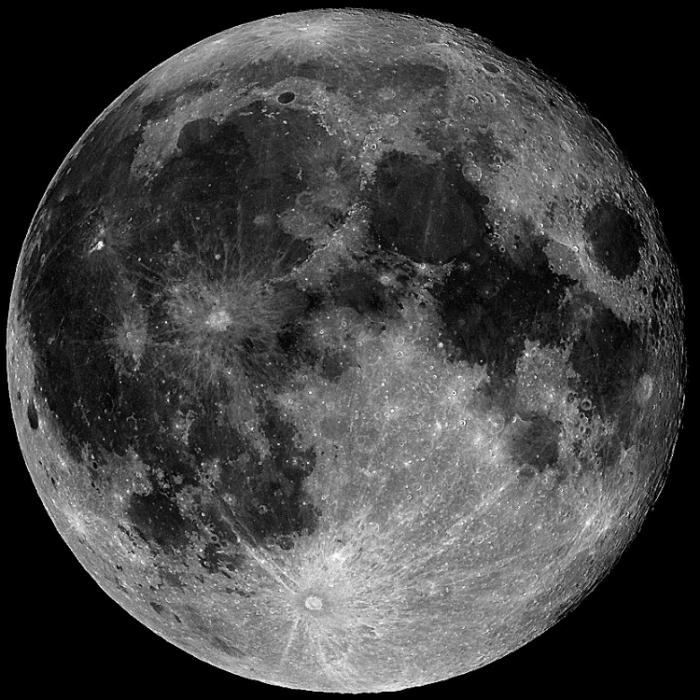

A Skygazer's Full Moon (22 December, 1999)
This dramatically sharp picture of the full moon was
recorded on 22 December, 1999 by astroimager Rob Gendler.
Big, beautiful,
bright, and evocative, it was the last full moon of the Y1.9Ks, pleasing and
inspiring even casual skygazers. December's moon was special for another reason,
as the full phase occurred on the day of the winter solstice and within hours of
lunar perigee.
The first full moon of the year 2000 will bring a special
treat as well, presenting denizens of planet Earth with a total lunar eclipse.
On Thursday evening, January 20, the moon will encounter the dark edge of
Earth's shadow at 10:01 PM Eastern Time with the total eclipse phase beginning
at 11:05 PM and lasting for 77 minutes.
This lunar eclipse will be visible
from North and South America and Western Europe (total phase begins at 4:05 AM
GMT January 21).
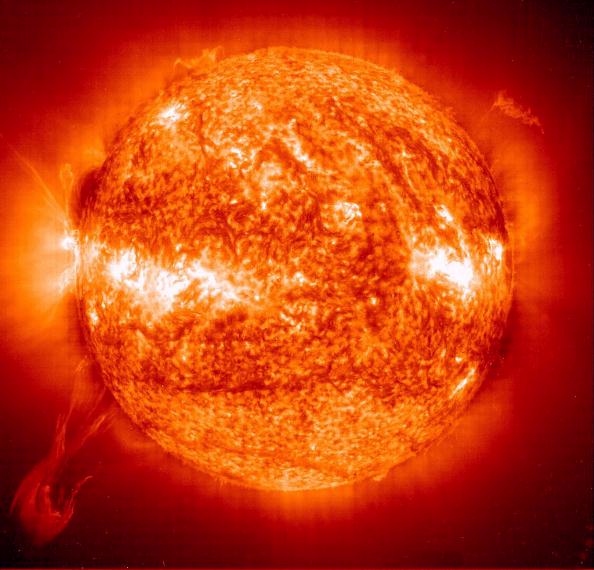
A Twisted Solar Eruptive Prominence
A huge eruptive prominence is seen moving out from our Sun in this condensed half-hour time-lapse sequence. Ten Earths could easily fit in the "claw" of this seemingly solar monster. This large prominence, though, is significant not only for its size, but its shape. The twisted figure eight shape indicates that a complex magnetic field threads through the emerging solar particles. Recent evidence of differential rotation inside the Sun might help account for the surface explosion. The sequence was taken early this year by the Sun-orbiting SOHO satellite. Although large prominences and energetic Coronal Mass Ejections (CMEs) are relatively rare, they are occurring more frequently now that we are near the Solar Maximum, a time of peak sunspot and solar activity in the eleven-year solar cycle.
SOHO Consortium, EIT, ESA, NASA
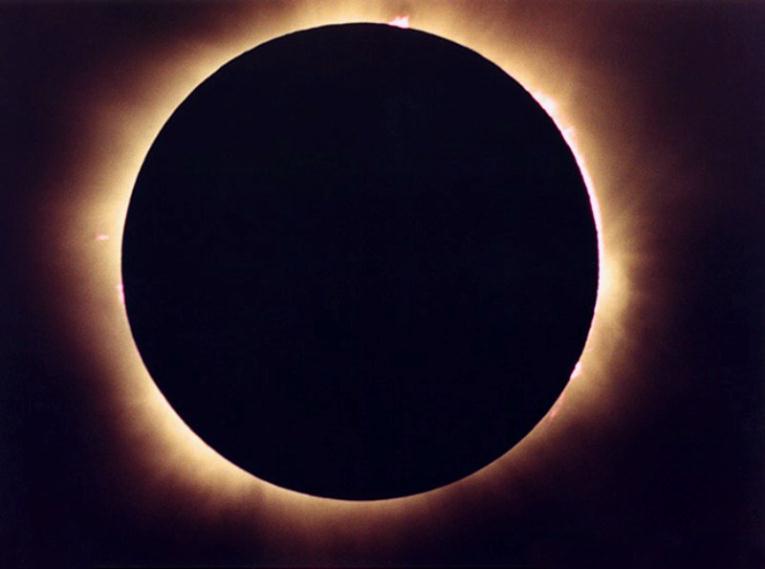
Total solar eclipse (1999, 11
august)
During a total solar eclipse, Earth's moon blocks the sun
- almost exactly. While the sun is about 400 times wider than the moon, it is
also about 400 times farther away and each appears to be half a degree or so in
diameter. On August 11, this remarkable coincidence in the apparent size of two
vastly different celestial bodies produced tantalizing solar spectacles for
denizens of Europe and Asia. For example, prominences along the sun's limb peer
around the moon's dark edge in this dramatic picture of totality recorded as the
lunar shadow swept across Hungary. Subtle structures in the sun's inner corona
are also visible streaming beyond the silhouetted moon.
This total eclipse of
the sun was the last to grace planet Earth's skies for this millennium. Although
four partial eclipses will occur in the year 2000, the next total eclipse will
not be until 2001 June 21.
Credit & Copyright: Dominik Pasternak
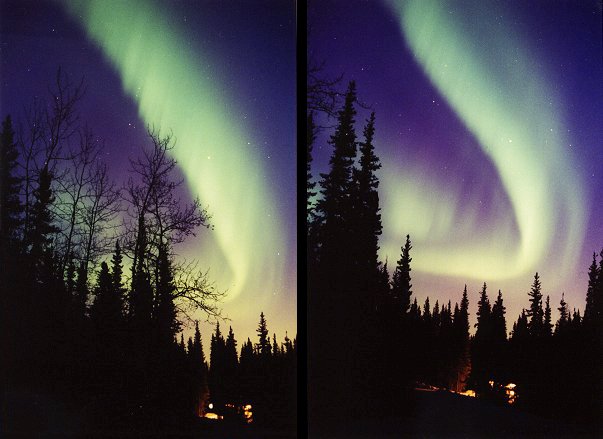
An Aurora Before the
Storm
Early April brought some of the most intense auroral storms this decade. An aurora on 1998, April 6 was reported to be the largest visible on Earth since 1989, and was seen throughout Europe and much of northern North America. On that day, many skywatchers expecting to see a rare alignment of planets were treated to a additional treat. Many reported aurorae with a relatively unusual red color. The above aurora recorded at dusk over Alaska sported the more typical green glow. A huge auroral ring can be seen superposed above trees and a building. Auroral activity occurs high in the Earth's atmosphere and is a direct result of storms on our Sun. As huge sheets of charged particles stream out from the Sun, a small fraction of these particles are funneled in by Earth's magnetic field and strike atoms high in the atmosphere, causing the sky to glow. The particles are harmless to people on Earth's surface, but can wreck havoc on satellites in orbit far above.
Credit & Copyright: Jan Curtis (U. Alaska), ACRC
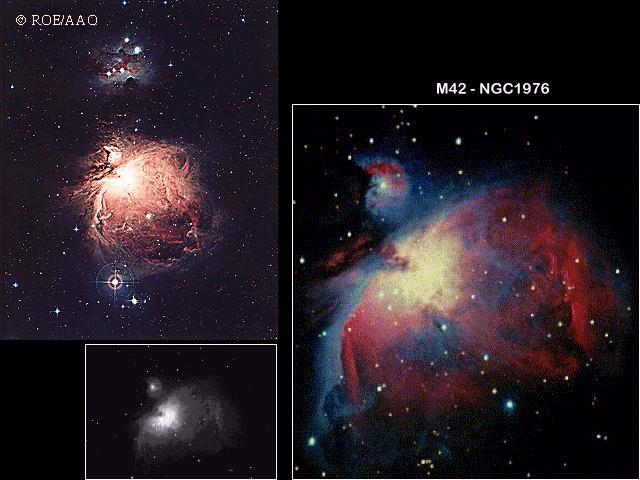
M 42 - The Orion Nebula (NGC 1976) - the middle 'star' in the sword of Orion the Hunter.
M 42 can be seen without optical aid as a hazy star, but
through even a small telescope it is a magnificent sight.
M 42 is the
brightest nebula visible from Earth and is thus the best studied. Its distance
is 1600 ly - relatively close. Many new stars are forming in the interior of the
cloud and several proto-solar systems have been discovered with infrared
astrophotography. Six inch and larger telescopes reveal a cluster of four stars
at the heart of the nebula called the Trapezium (the stars form the corners of a
regular trapezoid). These stars are among the youngest yet
discovered.
RA: 05 35.3 - DEC: -05 23 - MAG: 4
U2000:
225/226/270/271 - TIRION: 11 - SIZE: 66'X60'